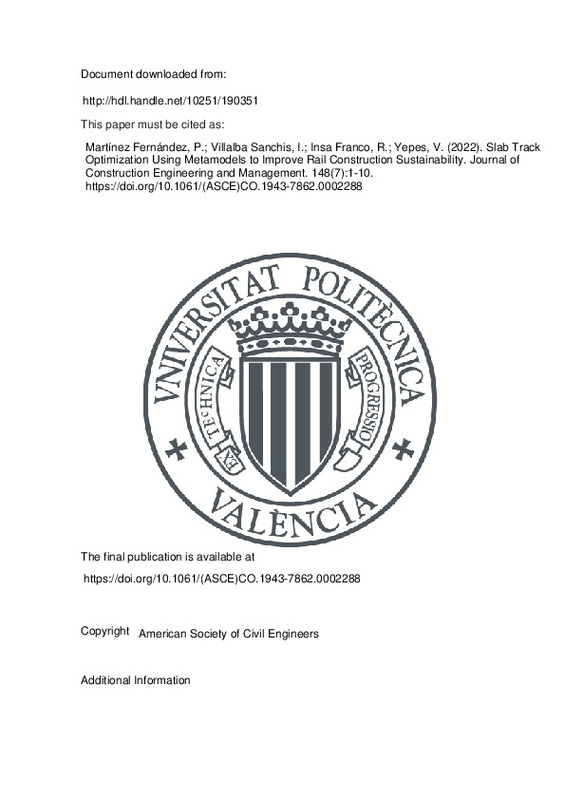JavaScript is disabled for your browser. Some features of this site may not work without it.
Buscar en RiuNet
Listar
Mi cuenta
Estadísticas
Ayuda RiuNet
Admin. UPV
Slab Track Optimization Using Metamodels to Improve Rail Construction Sustainability
Mostrar el registro sencillo del ítem
Ficheros en el ítem
| dc.contributor.author | Martínez Fernández, Pablo
|
es_ES |
| dc.contributor.author | Villalba Sanchis, Ignacio
|
es_ES |
| dc.contributor.author | Insa Franco, Ricardo
|
es_ES |
| dc.contributor.author | Yepes, V.
|
es_ES |
| dc.date.accessioned | 2022-11-29T19:03:07Z | |
| dc.date.available | 2022-11-29T19:03:07Z | |
| dc.date.issued | 2022-07-01 | es_ES |
| dc.identifier.issn | 0733-9364 | es_ES |
| dc.identifier.uri | http://hdl.handle.net/10251/190351 | |
| dc.description.abstract | [EN] Railways are an efficient transportmode, but building and maintaining railway tracks has a significant environmental impact in terms of CO2 emissions and use of raw materials. This is particularly true for slab tracks, which require large quantities of concrete. They are also more expensive to build than conventional ballasted tracks, but require less maintenance and have other advantages that make them a good alternative, especially for high-speed lines. To contribute to more sustainable railways, this paper aims to optimize the design of one of the most common slab track typologies: RHEDA 2000. The main objective is to reduce the amount of concrete required to build the slab without compromising its performance and durability. To do so, a model based on finite-element method (FEM) of the track was used, paired with a kriging metamodel to allow analyzing multiple options of slab thickness and concrete strength in a timely manner. By means of kriging, optimal solutions were obtained and then validated through the FEM model to ensure that predefined mechanical and geometrical constraints were met. Starting from an initial setup with a 30-cm slab made of concrete with a characteristic strength of 40 MPa, an optimized solution was reached, consisting of a 24-cm slab made of concrete with a strength of 45 MPa, which yields a cost reduction of 17.5%. This process may be now applied to other slab typologies to obtain more sustainable designs. | es_ES |
| dc.description.sponsorship | The authors wish to thank Joaquin J. Pons for his work, which was extremely helpful in the development of this paper. This project was supported by Grant PID2020-117056RB-I00 funded by MCIN/AEI/10.13039/501100011033 and by "ERDF Away of making Europe." | es_ES |
| dc.language | Inglés | es_ES |
| dc.publisher | American Society of Civil Engineers | es_ES |
| dc.relation.ispartof | Journal of Construction Engineering and Management | es_ES |
| dc.rights | Reserva de todos los derechos | es_ES |
| dc.subject | Slab track | es_ES |
| dc.subject | Optimization | es_ES |
| dc.subject | Latin hypercube | es_ES |
| dc.subject | Kriging | es_ES |
| dc.subject | Finite-element method (FEM) | es_ES |
| dc.subject.classification | INGENIERIA DE LA CONSTRUCCION | es_ES |
| dc.subject.classification | INGENIERIA E INFRAESTRUCTURA DE LOS TRANSPORTES | es_ES |
| dc.title | Slab Track Optimization Using Metamodels to Improve Rail Construction Sustainability | es_ES |
| dc.type | Artículo | es_ES |
| dc.identifier.doi | 10.1061/(ASCE)CO.1943-7862.0002288 | es_ES |
| dc.relation.projectID | info:eu-repo/grantAgreement/AEI/Plan Estatal de Investigación Científica y Técnica y de Innovación 2017-2020/PID2020-117056RB-I00/ES/OPTIMIZACION HIBRIDA DEL CICLO DE VIDA DE PUENTES Y ESTRUCTURAS MIXTAS Y MODULARES DE ALTA EFICIENCIA SOCIAL Y MEDIOAMBIENTAL BAJO PRESUPUESTOS RESTRICTIVOS/ | es_ES |
| dc.rights.accessRights | Abierto | es_ES |
| dc.contributor.affiliation | Universitat Politècnica de València. Escuela Técnica Superior de Ingenieros de Caminos, Canales y Puertos - Escola Tècnica Superior d'Enginyers de Camins, Canals i Ports | es_ES |
| dc.description.bibliographicCitation | Martínez Fernández, P.; Villalba Sanchis, I.; Insa Franco, R.; Yepes, V. (2022). Slab Track Optimization Using Metamodels to Improve Rail Construction Sustainability. Journal of Construction Engineering and Management. 148(7):1-10. https://doi.org/10.1061/(ASCE)CO.1943-7862.0002288 | es_ES |
| dc.description.accrualMethod | S | es_ES |
| dc.relation.publisherversion | https://doi.org/10.1061/(ASCE)CO.1943-7862.0002288 | es_ES |
| dc.description.upvformatpinicio | 1 | es_ES |
| dc.description.upvformatpfin | 10 | es_ES |
| dc.type.version | info:eu-repo/semantics/publishedVersion | es_ES |
| dc.description.volume | 148 | es_ES |
| dc.description.issue | 7 | es_ES |
| dc.relation.pasarela | S\462886 | es_ES |
| dc.contributor.funder | AGENCIA ESTATAL DE INVESTIGACION | es_ES |
| dc.contributor.funder | European Regional Development Fund | es_ES |
| dc.subject.ods | 09.- Desarrollar infraestructuras resilientes, promover la industrialización inclusiva y sostenible, y fomentar la innovación | es_ES |







![[Cerrado]](/themes/UPV/images/candado.png)

